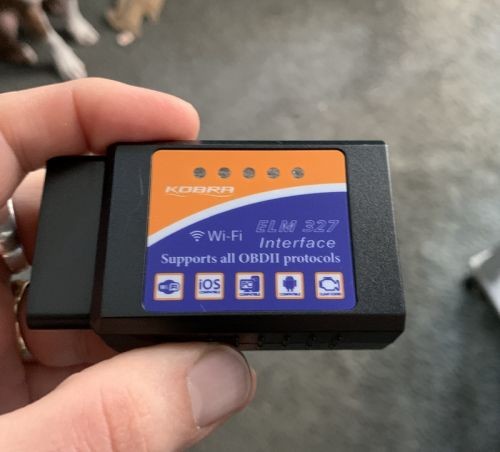Dealing with a check engine light can be a frustrating experience for any car owner. Recently, my own 2008 vehicle flashed that dreaded light shortly after a service, prompting me to explore a solution that wouldn’t break the bank. Like many, I sought advice from friends and colleagues, and the consensus pointed towards getting an OBD2 scanner. The idea was simple: diagnose the issue myself, understand the error code, and potentially even clear it if it was a minor sensor glitch. This led me to the Kobra OBD2 Scanner on Amazon, a device boasting over 2700 ratings, a database of 3000+ code definitions, and broad car model support. For around $20, it seemed like a worthwhile investment to gain some insight into my car’s health.
Image: Kobra OBD2 scanner device showcasing its compact design for vehicle diagnostics.
Like most OBD2 scanners, the Kobra offers connectivity via Wi-Fi or Bluetooth to link with your smartphone app and interpret the data from your car’s onboard computer. Before diving into the app experience, the initial step is locating your car’s OBD-II port. If you’re using a telematics device for insurance tracking, you’ll need to temporarily disconnect it to plug in the Kobra OBD2 scanner.
Once connected, the Kobra scanner powers up and is ready to communicate with your phone. This particular Kobra Obd2 Scanner Review focuses on the Wi-Fi model. Setting it up involves navigating to your phone’s Wi-Fi settings and connecting to the OBD2 scanner’s network.
The Kobra OBD2 scanner, described as an ELM327 WIFI Scanner and Car Scan Tool, claims to retrieve both generic and manufacturer-specific Diagnostic Trouble Codes (DTCs). It advertises compatibility with all car models from 1996 to 2016. While I only tested it on my 2008 model, the 2016 cut-off for newer vehicles is something to note. The product page also lists compatibility with numerous mobile apps like OBD Fusion, DashCommand, Torque, OBD Link, ScanMaster Lite, and OBD Car Doctor, available on both Apple and Google Play Stores. However, my experience revealed a different reality regarding app compatibility.
In my testing, many popular OBD2 apps failed to recognize or connect to the Kobra device. Apps like Garage Pro, FIXD, AutoDoctor, and Torque, among others, proved incompatible. It appears many OBD-II apps are designed to work exclusively with “their own” branded scanners, often relying on Bluetooth connectivity rather than Wi-Fi. The only app that successfully connected and functioned with the Kobra OBD2 scanner in my case was Car Scanner ELM OBD-2 from the iOS App Store. While other apps might work, be prepared for potential compatibility limitations, especially with Wi-Fi-based OBD2 scanners like the Kobra.
The Car Scanner ELM OBD-2 app, thankfully, offered a Wi-Fi connection option, unlike many apps that default to Bluetooth. The default IP/port settings worked seamlessly for connecting to the Kobra OBD2 scanner via Wi-Fi.
Once connected through the app, a range of features become accessible. The app interface typically includes dashboards, live data displays, sensor readings, and crucially, diagnostic trouble codes. My primary goal was to decipher the check engine light, so I navigated to the diagnostic trouble codes section. Before delving into the codes, let’s explore some of the other functionalities.
Image: Car Scanner ELM OBD2 app dashboard displaying real-time engine data such as RPM, speed, and coolant temperature.
The app provides real-time engine data, including RPM, speed, and temperature readings, allowing you to monitor your car’s performance dynamically.
It also offers insights into driving metrics like drive time, fuel usage, and fuel consumption, which can be helpful for tracking efficiency.
Image: Car Scanner ELM OBD2 app displaying vehicle voltage information, useful for monitoring battery and charging system health.
Furthermore, the app can display voltage information, providing a quick check on your car’s battery and charging system.
When I checked for error codes, the Kobra OBD2 scanner and Car Scanner app revealed codes P2004, P0128, P0522, and P0856. The P0856 code turned out to be an “inhibited test,” likely a false reading. After clearing the codes and restarting the car, the persistent code was P2004, indicating an “intake manifold air control actuator stuck open” error. Looking up this code provided valuable information about the issue and estimated repair costs from various sources.
This knowledge proved empowering. Armed with the diagnostic information from the Kobra OBD2 scanner, I could approach car repair shops with a better understanding of the problem. The strategy is to get a diagnosis from a mechanic without revealing your own scan results initially. Comparing their findings and price estimates with your research allows for informed decision-making and potentially negotiating a fair price or seeking alternative repair shops. While the Kobra scanner didn’t directly save me money on repairs, it gave me control and clarity about the car issue and its urgency. Knowing it wasn’t a critical problem allowed me to plan the repair around my budget.
The Kobra OBD2 Scanner is available on Amazon for a budget-friendly price of around $20. Despite the app compatibility limitations, which required some trial and error to find a working solution, the scanner ultimately delivered on its core function: diagnosing my check engine light. For the price, the potential savings and increased understanding of your car’s health make the Kobra OBD2 scanner a worthwhile tool for budget-conscious car owners. Just be prepared to spend a little time finding a compatible app, and manage expectations regarding the advertised broad app support.
Image: Amazon “Buy Now” button, visually representing the purchase option for the Kobra OBD2 scanner.
Justin Germino
